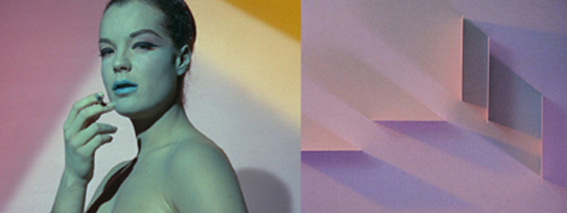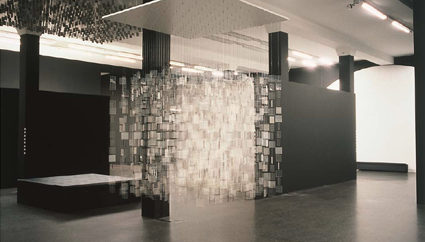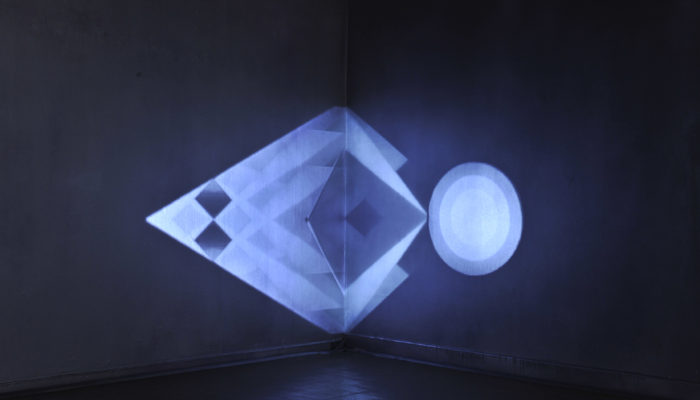
- This event has passed.
The End of the Night
October 17, 2013

Opening Reception: October 17, 2013,8–10pm
October 17-December 21, 2013
LACE is proud to continue the collaboration with Ceci N’est Pas… in presenting The End of the Night, organized by curator Martha Kirszenbaum and designed by Exhibition Designer Marianne Zamecznik, is a bold group exhibition exploring the impact of French filmmaker, Henri-Georges Clouzot and his unfinished 1963-1964 film, L’Enfer, on notions of abstraction, the kinetic, and optical illusions in contemporary French art. For this exhibition, Kirszenbaum has invited five artists whose works reflect on Clouzot’s pictorial and sound experimentation and respond to his visual and sensorial imagination: a historical figure, Julio Le Parc, and four emerging artists, Florian & Michael Quistrebert, Isabelle Cornaro and Pierre-Laurent Cassière. Kirszenbaum’s project is a double exhibition — the other half taking place at the Palais de Tokyo in Paris, emphasizing a similarly themed exploration of the work of Los Angeles experimental filmmaker Kenneth Anger.
L’Enfer is an unfinished, psychological drama depicting the obsessional jealousy of its main character, Marcel Prieur, for his attractive wife. The film utilizes a binary, intricate structure: the couple’s everyday life in the hotel they manage is filmed in black and white with a conventional soundtrack, but Marcel’s sudden jealousy crisis and madness attacks perturb his perceptions, and make him see and hear a distorted reality where the characters become vividly spotted in revolving acid colors, while the surrounding sound turns into a magma of screams, noises and accelerated whispers. As a result of Clouzot’s obsession with technical experimentation, the film incorporates the hallmarks of kinetic and optical art along with sound effects in order to express its main character’s jealousy, madness and nightmare.
Watch curator Martha Kirzsenbaum discuss the exhibition!
Video edited by Amanda Mears.
Florian & Michel Quistrebert, The 8th Sphere, double channel video installation, 1’41 looped, 2010.ABOUT THE ARTISTS
Julio Le Parc (b. 1928 in Argentina, lives and works in Cachan) is the pioneer of French optical art and founder of the group GRAV (Research Group on Visual Art). His objects, sculptures, installations and paintings are labyrinthine experiments, distorting the senses and the vision. His practice relies on dematerialization, perceptive haze, formal reduction, artificial lights, environments, the audience’s implication, and varying levels of vision. He directly collaborated with Henri-Georges Clouzot on his last film, La Prisonnière (1968), and the director appropriated some of Le Parc’s experimentals in the visual techniques he used for L’Enfer. The works presented in the exhibition challenge perceptual abstraction while provoking a multiple distorted vision, such as Element Mouvement Surprise (1966) and Forme Virtuelle par Déplacement (1966), playful objects that engage the viewer’s multiplied distorted senses. His series of Continuels Mobiles (1959 onwards) are illuminated mirror-like plastic or metal squares suspended in vertical rows that move with the wind, capturing the fleeting images of the room. The light is therefore diffused in every direction of the obscured exhibition space, provoking a disrupted effect that propagates the continually changing reflections.
Collaborative duo Florian & Michael Quistrebert(b. 1982 and 1976 in France, live and work in Amsterdam and Paris) have grounded their practice in abstract painting, video, invoking incisive geometrical forms, architectural structures and experimental imagery. Their series of paintings Gradient comprises multi-layered pieces playing with atmospheric spray-paint and bleach technique, realized through a reversed photographic technique, where the bleach simultaneously illuminates and erodes the canvas. With images made of shadows, smoke, or light reflection, they create videos of art-deco aesthetics along with strong mystical references that recall early 1930s movies. The video-installation The Eighth Sphere is based on a double channel projection where the same sequence is shown on both sides of a chrome painted corner. While both projections are symmetrical in space, they are also desynchronized in time, creating a mirror effect that builds up through the viewer’s memory. Reminding of geometrical abstraction and early experimental cinema, such as Hans Richter or Laszlo Moholy-Nagy, the projected images actually come from edited captures of shadows.
Isabelle Cornaro (b. 1974 in France, lives and works in Paris) constructs objects and sculptures that often exist outside of their physicality, seen in perspective and low-angle shot, as in her films where she uses slow pans to set the objects like landscapes or in a static way like statues, and extreme close-up views to soften their silhouettes into abstract shapes, reminiscent of the images of experimental film. The subject of her films self-reflectively mirrors the cinematic process. Floues et colorées [Blurred and colored] (2010) frames the amorphous patches of color emanating from cans of spray paint. In De l’argent filmé de profil et de trois quarts [Money filmed from a side view and a three-quarter view] (2010), bills and coins are observed from a point of view that without metaphor or allusion corresponds to its title. In Du Cinématique (2011) and Reproduction (2012), the viewer’s perception shifts facing large, almost pixelated panels of acrylic paint sprayed on paper or directly on the wall.
Pierre-Laurent Cassière (b. 1982 in France, lives and works in Paris) oscillates between producing sound installations, expanded cinema and performance practice, interrogating vibrating fields and plays with the limits of the viewer’s perceptions. Influenced by the archeology of media, his systems turn audiovisual technologies into minimal and contemplative experiences. In his sound installation Pulse (2010-2012), low frequencies sound emissions are produced by elements installed in the exhibition space. Through cinema’s optical sound technique, a small and silent light mill called “Crookes radiometer” is transformed into a powerful noise generator. The disturbing light, coming from a slowly flicking bulb, generates the motion of the mill, which wings alternatively obstruct a laser ray pointed on a photo sensor. Once amplified, the signal is directly transmitted to the architecture through low frequency transducers, resulting in shaking the walls, reversing the senses and provoking a strong disoriented feeling within the vibrating exhibition space.
ABOUT THE CURATOR
Martha Kirszenbaum (b.1983) is an independent curator based in Paris. She worked at the Department of Media and Performance at the Museum of Modern Art in New York, the Cabinet of Photography at Centre Georges Pompidou, and as a research assistant at the New Museum, New York. Independently, she has organized exhibitions, projects and screenings in the United States (Austrian Cultural Forum, New York; Harris Lieberman Gallery, New York), Europe (Palais de Tokyo, Paris; Galerie Crèvecoeur, Paris; European Culture Congress, Wroclaw; Institute for Contemporary Art, London; Tramway, Glasgow) and at the 2012 Marrakech Biennale. She was a curator-in-residence at the Center for Contemporary Art in Warsaw, and guest curator at the Belvedere Museum/21er Haus in Vienna where she organized two interventions on the collection in 2012. In addition to The End of the Night, she is organizing a companion exhibition later this year at Palais de Tokyo (Paris). She regularly contributes for Kaleidoscope, L’Officiel, and Voxpop, and has led seminars on curatorial practices at Université Paris VIII and Parsons Paris.
ABOUT THE EXHIBITION DESIGNER
Marianne Zamecznik is a curator and exhibition designer based in Berlin, educated at the Oslo National Academy of the Arts and University College of Arts, Crafts and Design in Stockholm. Recent projects include Revealing Thoughts at Grand Palais, Paris; Rosa Tannezapfen – The Choreography of Species at the 7th Momentum biennial; The Running Room at Space for Art and Industry, New York; The Feast at the European Culture Congress, Wroclaw, Poland; the 6th Momentum biennial, Moss, Norway; The Space Between Us, the Modern Museum of Warsaw. She is editor for a book on exhibition architecture with Carson Chan.
ABOUT CECI N’EST PAS…
Ceci n’est pas… is a project initiated by the Cultural Services of the French Embassy in the United States in association with the Institut Français, with the support of the Alliance Française of Los Angeles, the French Ministry of Culture and Communication and the participation of many local institutions.
Ceci n’est pas… began on December 1, 2012 with the opening of the exhibition LOST IN LA, organized by the FLAX Foundation and continues for 5 months, ending in April 2013. It will gather more than 30 Franco-American collaborations that are being prepared by art centers, museums, art schools and non-profit organizations in Los Angeles, covering a large spectrum of contemporary creation, from sculpture to performance, and from architecture to video. Learn more and join the conversation at cnp-la.org.
SUPPORT
Support for The End of the Night is granted by Ceci n’est pas…Art Between France and Los Angeles, OCA – Office for Contemporary Art Norway, the Norwegian Consulate General in San Francisco, Guest Haus Residency, Natalie Rekstad-Lynn, and Ralph and Trisha N. Nagel.


